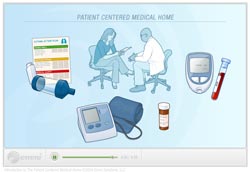You are looking at an archived version of our site. Please visit thepcc.org for a fresh, new experience!
History
The patient-centered medical home, while not a new concept, has evolved to define a model of primary care excellence that is patient-centered, comprehensive, coordinated, accessible, and committed to quality and safety. Below is a description of key events over the primary care medical home's lifetime.
Key Events
1967
The American Academy of Pediatrics (AAP) introduces the term “medical home” to describe primary care that is accessible, family-centered, coordinated, comprehensive, continuous, compassionate, and culturally effective.
1978
The Declaration of Alma-Ata is introduced at the International Conference on Primary Health Care, and is the first international declaration of primary health care's key role in promoting the health of all people. The World Health Organization (WHO) lends its support of this principle in their Primary Health Care report of the same year.
1996
Influenced by the Declaration, The Institute of Medicine (IOM) publishes Primary Care: America's Health in a New Era and redefines primary care as "the provision of integrated, accessible health care services by clinicians who are accountable for addressing a large majority of personal health needs, developing a sustained partnership with patients, and practicing in the context of family and community." The publication also mentions medical home.
2002
- The seven national family medicine organizations launch The Future of Family Medicine (FFM) project and produce The Future of Family Medicine: A Collaborative Project of the Family Medicine Community. The report recommends that health system change will "include taking steps to ensure that every American has a personal medical home [... and] developing reimbursement models to sustain family medicine and primary care."
- The Chronic Care Model is born and emphasizes the critical role of primary care to prevent, manage, and treat chronic illness.
2005
Renowned researcher and primary care champion Dr. Barbara Starfield publishes Contribution of primary care to health systems and health, a seminal work that acknowledges the six primary care mechanisms that benefit health: (1) greater access to needed services (2) better quality of care (3) a greater focus on prevention (4) early management of health problems (5) the cumulative effect of primary care delivery; and (6) the role of primary care in reducing unnecessary or harmful specialty / inpatient services.
2006
- The American College of Physicians (ACP) develops The Advanced Medical Home: A Patient-Centered, Physician-Guided Model of Health Care and proposes fundamental changes in the way primary care is delivered and paid for.
- The Patient-Centered Primary Care Collaborative (now known as the Primary Care Collaborative) is founded by a group of large employers, including IBM, and the major primary care physician associations: American Osteopathic Association (AOA), American Academy of Family Physicians (AAFP), American College of Physicians (ACP), and American Academy of Pediatrics (AAP). The organization is charged with building a national movement that promotes widespread adoption of the patient-centered medical home.
2007
The major primary care physician associations develop and endorse the Joint Principles of the Patient-Centered Medical Home.
2008
- The National Committee for Quality Assurance (NCQA), URAC, Joint Commission, and the Accreditation Association for Ambulatory Health Care (AAAHC) launch medical home accreditation programs.
- The Commonwealth Fund launches the five-year Safety Net Medical Home Initiative designed to help 65 community health centers in five states transform into patient-centered medical homes.
2010
The Patient Protection and Affordable Care Act (ACA or health care reform law) is signed into law by President Barack Obama on March 23rd, and includes numerous provisions for enhancing primary care and medical homes, such as primary care payment increases through Medicare and Medicaid, expansion of insurance coverage, and signifcant investments in medical home pilots, workforce development and training, prevention and wellness, community health centers, and additional care delivery innovations.
2011
As a result of the Affordable Care Act:
- Primary care providers receive a 10% Medicare bonus payment for primary care services.
- A new Medicaid state option is created to permit certain Medicaid enrollees to designate a provider as a health home, and states taking up the option receive 90% federal matching payments for two years for health home-related services.
- Small employers receive grants for up to five years to establish wellness programs.
- The Center for Medicare & Medicaid Innovation launches the Pioneer Accountable Care Organization (ACO) Model and Advance Payment ACO Model, which offers shared savings and other payment incentives for selected organizations that provide efficient, coordinated, patient-centered care.
- States begin planning for the establishment of American Health Benefit Exchanges and Small Business Health Options Program Exchanges, which facilitate the purchase of insurance by individuals and small employers.
- Teaching Health Centers are established to provide payments for primary care residency programs in community-based ambulatory patient care centers.
2012
- According to the National Academy for State Health Policy, 47 states have adopted policies and programs to advance the medical home.
- Representing more than 1,000 members, Primay Care Collaborative publishes Benefits of Implementing the Medical Home: Cost and Quality Results providing cost, quality and outcomes data for more than 40 medical home initiatives throughout the U.S.
2013
As a result of the Affordable Care Act:
- States indicate to the Secretary of HHS whether they will operate a health insurance marketplace.
- Medicaid payments for primary care services increase to 100% of the Medicare payment rate through 2014.
- Providers receive a one percentage point increase in federal matching payments for preventive services.
- Essential Health Benefits in the health insurance marketplaces include prevention, wellness, and chronic disease management.
What's New
August 16, 2024
- Page 0
- ››





